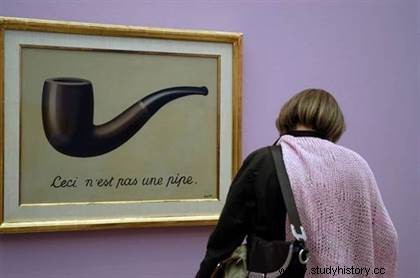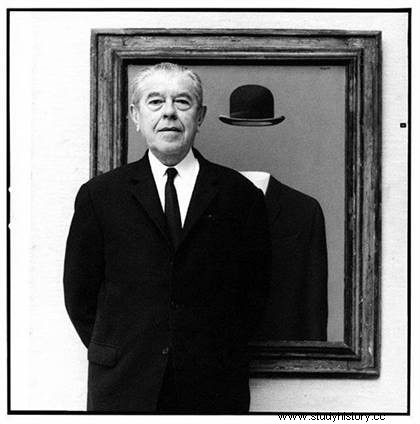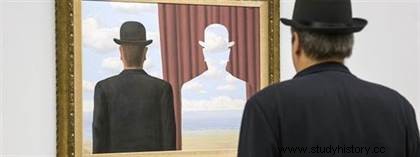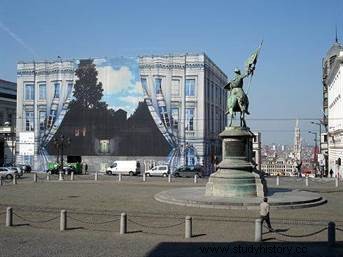 Short biography - Of Belgian origin, René Magritte (1898-1967) was a complete artist, in turn surrealist painter, engraver, sculptor, photographer and filmmaker. He was part of this generation of young people who revolted after the dead of the First World War and to "evacuate" this feeling of oppression, gathered around the writer André Breton to found the surrealist movement. They will paint the strange, the bizarre with real objects, placed in an imaginary and irrational world.
Short biography - Of Belgian origin, René Magritte (1898-1967) was a complete artist, in turn surrealist painter, engraver, sculptor, photographer and filmmaker. He was part of this generation of young people who revolted after the dead of the First World War and to "evacuate" this feeling of oppression, gathered around the writer André Breton to found the surrealist movement. They will paint the strange, the bizarre with real objects, placed in an imaginary and irrational world.
The life of René Magritte
René Magritte was born on November 21, 1898 in Lessines, Belgium. Of his two brothers, Paul will be his favorite, being gifted for poetry and music. From Châtelet in 1910, the family moved to Charleroi in 1913, a year after her mother's suicide in the Sambre. He met Georgette Berger, then officially began painting in 1915. Enrolled at the Academy of Fine Arts in Brussels in 1916, he exhibited his first two drawings and his first two canvases.
He then frequented avant-garde artists such as Pierre Bourgeois, was attracted by the Dada movement, then by surrealism. He befriends Paul Nougé and Camille Goemans. The big click occurs when Louis Scuténaire shows him a work by Chirico. Thanks to this Italian painter, he painted L’homme du large and The Midnight Wedding . In 1918, a poster was published based on one of his projects and his drawings appeared in a magazine in 1919. Having found Georgette in 1920, he never left her and they married in 1922. To earn a living, Magritte designs wallpapers and advertising motifs for fashion houses. He also participates in some exhibitions in Belgium and abroad.
 In 1926 he painted The Lost Jockey , a painting considered to be the first of his “work” and adheres to the group of Belgian surrealists which has just emerged, made up of Magritte, Mesens, Goemans and of course Nougé. Two years later, he exhibited around sixty works at the Le Centaure gallery in Brussels, but the success was not at all forthcoming. He decides to leave for France and settles in the suburbs of Paris. During this period, he directed The Secret Player andThe Blood of the World. In 1929, he presented La Trahison des images, a painting or figure in the caption "This is not a pipe".
In 1926 he painted The Lost Jockey , a painting considered to be the first of his “work” and adheres to the group of Belgian surrealists which has just emerged, made up of Magritte, Mesens, Goemans and of course Nougé. Two years later, he exhibited around sixty works at the Le Centaure gallery in Brussels, but the success was not at all forthcoming. He decides to leave for France and settles in the suburbs of Paris. During this period, he directed The Secret Player andThe Blood of the World. In 1929, he presented La Trahison des images, a painting or figure in the caption "This is not a pipe".
Magritte and Parisian Surrealism
Invited to Dali in Cadaques in 1929, Magritte met Bunuel and Paul Eluard. Back in Paris, André Breton integrates him into the circle of the Surrealists. He then frequented the brothers Prévert, Tanguy, Miro and exhibited for the second time in 1930 in Paris rue de Seine, this time it was collages.
Falling out with Breton, he returned to Brussels and with other artists worried about the rise of Nazism, he participated in 1934 in the manifesto L'Action Immédiate and collaborated with the communist newspaper the Voice of the People in 1936. After an exhibition at the Julien Levy Gallery in New York the same year, he spent 3 weeks in London to show his works there and talk about his creations.
 During the occupation of Belgium, he fled to Carcassonne to his friend the poet Joé Bousquet, but finally returns after a few months in Brussels. During the war, he painted The Return in 1940, when the bird and Magritte blue appeared recurrently, and in 1943 began his “full sun” period resembling Impressionist painting. After the exhibition, Marc Eemans describes these works as "degenerate art" in a Flemish pro-Nazi newspaper. At the Liberation in 1945, Magritte joined the Communist Party (an action he would regret some time later) and published an article on the painter James Ensor in the newspaper Le Drapeau Rouge. Some beautiful works made between 1945 and 1950 are influenced by Matisse.
During the occupation of Belgium, he fled to Carcassonne to his friend the poet Joé Bousquet, but finally returns after a few months in Brussels. During the war, he painted The Return in 1940, when the bird and Magritte blue appeared recurrently, and in 1943 began his “full sun” period resembling Impressionist painting. After the exhibition, Marc Eemans describes these works as "degenerate art" in a Flemish pro-Nazi newspaper. At the Liberation in 1945, Magritte joined the Communist Party (an action he would regret some time later) and published an article on the painter James Ensor in the newspaper Le Drapeau Rouge. Some beautiful works made between 1945 and 1950 are influenced by Matisse.
In 1948, it was his "cow period" for three months, made of caricatures. Despite this interlude, he managed to exhibit 15 paintings of this kind, in Paris at the Galerie du Faubourg. But she is decried, because we do not expect this kind of painting from her. Magritte was also in a period of black humor and cruelty when he painted his coffin figures in 1951.
World famous
In 1952, he completed a mural for the Knokke-le-Zoute casino, Le Enchanted Domain , then exhibited in London, Paris, New York and Rome; in 1954, at the Palace of Fine Arts in Brussels, and again in Liège. The Guggenheim Prize was awarded to him in 1956 and the Palais des Beaux-Arts in Charleroi commissioned a mural fresco from him which he entitled La Fée Ignorante . The one called The Mysterious Barricades goes to the Palais des Congrès in Brussels.
The name of Magritte began to be known throughout the world in 1960, and his work would influence Pop Art. Over the next five years, Dallas and Houston presented a retrospective of 82 works, the Walter Art Center in Minneapolis exhibited 92, 100 at Saint Thomas University in Houston and the Museum of Modern Art in New York.
René Magritte can still attend the last retrospective of 105 of the most important paintings, at the Boymans-van-Beuningen museum in Rotterdam in 1967, before dying suddenly on August 15 in Brussels. But until the end of his life, he painted superb canvases including The Empire of Lights and the last realized is The blank page.
His work
The whole of his work, about 1500 paintings and drawings represent simple objects of everyday life, as well as the man and the woman.
René Magritte said "the art of painting can only really be limited to describing an idea that shows a certain resemblance to the visible that the world offers us ". By painting real objects, he projects us into another universe. It encourages us to take a different look at the simple things around us. The human eye, or the human feeling very often deforms the nature of things and Magritte thus wanted "to regenerate the power of the human eye, to restore to it its primitive acuity and to arouse images charged with an emotion such as that experienced in his youth ". To all those who asked him what he had meant in such and such a work, he answered "nothing other than what you see yourself .
 The "Lost Jockey his first work, produced in 1926, has nothing very special:no cubism, no impressionism, no fauvism, no dadaism, but only objects represented naturally and yet which give off an impression of unheard of. Take a man on a horse, crossing a landscape composed of trees painted in the form of large leaves where only the veins remain. But where is he running to? Maybe in a second world.
The "Lost Jockey his first work, produced in 1926, has nothing very special:no cubism, no impressionism, no fauvism, no dadaism, but only objects represented naturally and yet which give off an impression of unheard of. Take a man on a horse, crossing a landscape composed of trees painted in the form of large leaves where only the veins remain. But where is he running to? Maybe in a second world.
“The Man of Magritte », universally known, dates from 1953. He is always represented in the same way:solitary, straight, stiff, anonymous, with his black hat. As if the man “is stuck in his sad existence”. However, his face is unknown and regularly hidden by an apple or a bird.
“The Beautiful World made in 1962, all in blue and white, yet with a green stain. A window is open to a blue sky and light white clouds. We escape towards this sky which calls us and attracts us. On either side, a curtain held by a turquoise blue tieback. The only green touch:the apple. A fruit that brings us back to reality.
The Magritte Museum
On June 2, 2009, the Musée Magritte Museum opened on Place Royale in Brussels. In one month, more than 500,000 visitors came and were able to discover Magritte, in a dark environment (the walls being slate blue and midnight blue) conducive to bringing out his light painting made of sky blue and white.
More than 200 works are exhibited on 5 floors, some lent by private collectors, and for the most part proposed by the president of the Magritte Foundation Charly Herscovici, the painter's heir. All these paintings and other objects chronologically retrace the periods of his life. A very rich collection made up of oils, gouaches, drawings, advertising posters, photos, objects such as painted bottles, films, all of this produced by Magritte. Three important parts of his life are thus presented: 
- the first 30 years of his life where he made major encounters, his discovery of de Chirico, his drawings that appeared in magazines, stage frights in which he participated, personal writings .
- The next 20 years and represent his period of "imbecile work", a term he himself used to designate his advertising drawings.
- The last 16 years during which he has traveled the world and painted frescoes such as the "Enchanted Domain".
There is another place of memory:the house he occupied between 1930 and 1954 in Brussels rue Esseghem, where you can discover his original furnished living room, his workshop in the garden as well as some personal items.
Bibliography
- Magritte:His work, his museum by Michel Draguet. 2009.
- Magritte by David Sylvester. 2009.
